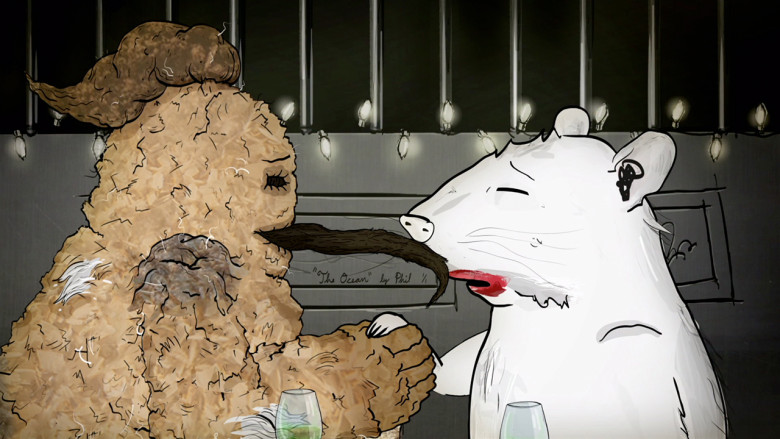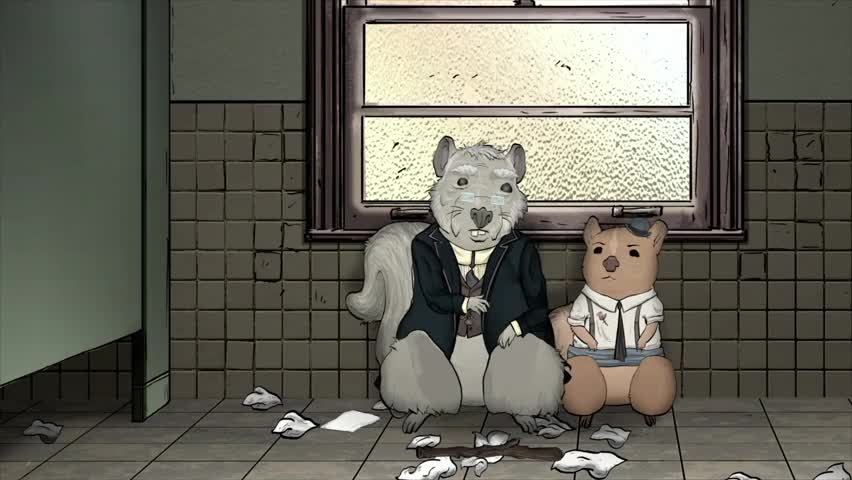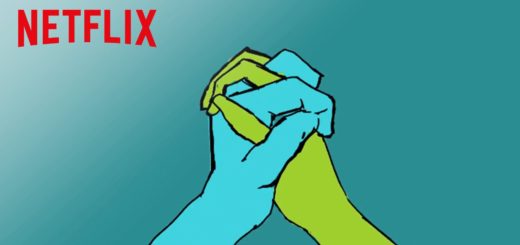ANIMALS Season Two Review

When Mike Luciano and Phil Matarese premiered their mumblecore cartoon, ANIMALS, in February of 2016, it was immediately apparent who their fanbase would be. To call it niche would be an understatement. An entire animated series focused on the domestic and emotional issues of the rodents, house pets, and insects that inhabit Manhattan was not only too mature for children, but patently avoided the visual panache of even the most adult-centric cartoons. For better or worse, ANIMALS was never and will never be a BOJACK HORSEMAN. It is a show that might as well be talk-radio, aided by adorable visual cues that render a mob boss into a fluffy kitten. With the second season of ANIMALS concluded, Materese and Luciano gear up for their confirmed third installment, and though they have yet to reignite the flame that made their first season so memorable, they haven’t lost the spark.
As I had already mentioned in my Hit or Sh** article in 2016, season one of ANIMALS was an absolute delight. Each episode felt distinct in its mission statement, touching on subjects of interracial romance, gender dysphoria, and good old fashioned revenge-murder, impeccably cast and told through its charming art style. Luciano and Matarese have always been concerned with the topics at the center of their narratives. Visuals have always been secondary. Still, season one accomplished something rather unique amidst its 10-episode anthology: it used a connective tissue centered around the humans of New York (not the photography page, duh) as a means of telling an entirely visual storyline. Where each animal’s tale was dictated entirely by dry-wit rhetoric, the human narrative of a corrupt mayor’s rise and fall was a piece of vocal gibberish, only legible through its visual storytelling. Not only did this give ANIMALS a much needed longevity, urging viewers to tune in next week, but it found a way to connect the lives of all its disparate creatures.

Stuart Little is a big boy now
ANIMALS’ second season sought to imitate its predecessor. And why not? No point in fixing something that isn’t broke. The problem is that Luciano and Matarese somewhat lost sight of what made their overarching narrative so compelling; namely, the visual plot that indirectly found its way into the lives of each and every animal, even if minimally. Season two picks up exactly where episode 110 ended, with our two rats, Mike and Phil, held in a lab. What could have easily made for a fascinating 10 episode run about animal experiments and an ensuing escape a la FINDING NEMO was brushed aside by the end of the first episode. It’s a shame, because episode 201 still registers as the highlight of the season, employing the show’s wacky domestic rivalries within the framework for a “larger-than-animal-life” narrative.
This connecting tissue centers around Dr. Labcoat (RuPaul; no, really, it’s actually RuPaul) and his evil plot to control mankind. It’s rather absurd, but it absolutely works for the canvas of ANIMALS. In fact, I had no problem with the greater narrative until episode 205, the aptly titled “Humans.” It might sound aggressive, but I can’t shake the feeling that these 30 minutes utterly betrayed ANIMALS’ formula, a live-action in-joke that serves no purpose but to explain Dr. Labcoat’s evil plot. It rubs me the wrong way for multiple reasons, but its most egregious sin is that it undermines Luciano and Matarese’s only opportunity to actually tell a visual story with their season. After episode 205, the storyline feels like an elongated action set piece, slowly plodding to its imminent end with no charming, or otherwise insightful, visual statement at the climax. At least in season one, Dany MacBride’s revenge-seeking turkey held a 9mm to the mayor’s face. In season two, I want nothing but to get back to my eponymous animals, so why waste my time with this human nonsense?

“Hey son, take a look at my nuts.” – Uncle Chester
And still, there’s a lot of fun to be had over the course of season two’s 10-episode stretch. “1. Rats”, “2. Pigeons”, “3. Roaches”, and “9. Squirrels, Birds, Possums” stand out as the season’s four distinct highlights, each tackling different genre conventions and psychological crises with the deftness and confidence that I expect of ANIMALS. The latter of the four stands out particularly, mediating a rather adorable discourse on the circle of life (and the fact that these critters actually eat each other). It’s a little disappointing that much of the remaining episodes either reiterate or lean too heavily on themes tackled in the first season, pitting two characters against each other, oftentimes as the result of an inferiority complex. In addition, a two-episode stretch on cats playing gangsters was utterly useless and uninteresting, especially when compared to the far more entertaining mockumentary tracking six pigeons confined to a plastic six-pack (the season’s funniest episode).
It’s a shame that season two of ANIMALS is so hit-or-miss, because it’s frankly one of HBO’s most inventive properties, not to mention the Duplass Brothers’ most formally inventive IP. Mumblecore has always felt somewhat hampered by its own boring style: prioritizing dialogue over aesthetics. ANIMALS is a welcome detour from this norm, and though season two hasn’t exactly brought the goods I’ve hoped for, I trust that Matarese and Luciano can rediscover what makes their show so affecting. There is an infinite amount of room to expand the ANIMALS universe, and if just a little more time and thought is put into what each of these creatures experience on a day-to-day basis, then we might not fall into as many been-there-done-that traps. ANIMALS certainly hasn’t lost any of its charm, it just needs to push itself to find new thematic ground to cover.
Verdict: Do Not Recommend



